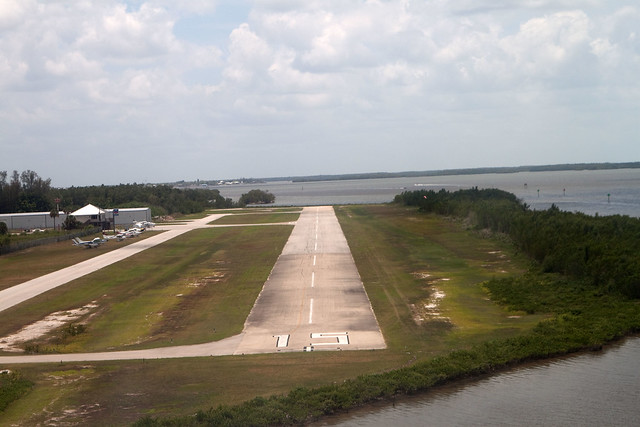asechrest
En-Route
Hi folks.
I’m considering a trip with the family to Everglades Airpark (X01). It would be, by quite a bit, the shortest runway I have operated on. I trained in a 172 at an airport where the shortest runway I operated from was 4,700ft. Recently I joined a club that operates an Archer II from a runway of 3,300ft. Everglades Airpark is 2,400ft. I am a low-time pilot with 100hrs.
Would like to just post the thought process I’m going through so folks can comment, especially those with Archer II experience.
The airport has a single asphalt runway 15/33, 2400 x 60 ft with takeoff and approach over the water. Runway 15 has obstructions -- 39 ft. trees, 1235 ft from runway, 26:1 slope to clear -- which looks to me to be a little tree island in the water. No obstructions for 33.
The weekend is forecast to have a high temp for the day of 85F, so let’s be conservative and use 90F = 32C. Forecast winds to be 5 knots or so and varying in direction during the day.
The plane is a 1977 Piper Archer II – PA-28-181. Gross weight is 2550 lbs and with full fuel, the girlfriend, two kids, and 50 lbs in the baggage department, I’ll be 2300 lbs or less. CG well within limits. I’d be using short field takeoffs and landings. The POH calls for:
With basically no real obstacles since takeoff is over the water, I’ve been focusing on the ground roll chart for the 25 degree flaps takeoff. Using 32C, sea level, 2300 lbs, and no wind, gives a ground roll of less than 1000 ft. This leaves tons of wiggle room. Seems fine. (Takeoff over a 50ft obstacle would be less than 1700ft, still fine. )
Similar charting for the landing shows a hair less than 900 foot ground roll performance, and a bit less than 1,400 feet landing performance over a 50 foot barrier. Like many flights, the landing is the tough part and what I’m focusing on. I don’t have a lot of true short field experience but for all of my landings I try to use the POH short field technique with the exception of maximum braking.
--
In summary, this seems well within the abilities of the plane. But it's the loose nut behind the wheel that's usually the limiting factor, and I am a low-time pilot and want to be conservative. If we opt to make the trip I’ll probably start out by doing pattern work with short field landings at the home base just to get in the groove before setting off to the destination.
Those of you with Archer II experience, what short runways have you operated out of?
Thanks.
[EDIT] - Fixed fond and display issues.
I’m considering a trip with the family to Everglades Airpark (X01). It would be, by quite a bit, the shortest runway I have operated on. I trained in a 172 at an airport where the shortest runway I operated from was 4,700ft. Recently I joined a club that operates an Archer II from a runway of 3,300ft. Everglades Airpark is 2,400ft. I am a low-time pilot with 100hrs.
Would like to just post the thought process I’m going through so folks can comment, especially those with Archer II experience.
The airport has a single asphalt runway 15/33, 2400 x 60 ft with takeoff and approach over the water. Runway 15 has obstructions -- 39 ft. trees, 1235 ft from runway, 26:1 slope to clear -- which looks to me to be a little tree island in the water. No obstructions for 33.
The weekend is forecast to have a high temp for the day of 85F, so let’s be conservative and use 90F = 32C. Forecast winds to be 5 knots or so and varying in direction during the day.
The plane is a 1977 Piper Archer II – PA-28-181. Gross weight is 2550 lbs and with full fuel, the girlfriend, two kids, and 50 lbs in the baggage department, I’ll be 2300 lbs or less. CG well within limits. I’d be using short field takeoffs and landings. The POH calls for:
SHORT FIELD, OBSTACLE CLEARANCE
Flaps 25 deg (second notch)
Accelerate to 41 – 49 KIAS depending on weight
Rotate
After breaking ground, accelerate to 45 – 54 KIAS depending on weight
Accelerate to best flaps up angle of climb speed – 64 KIAS, slowly retract flaps and climb past obstacle
Accelerate to best flaps up rate of climb speed – 75 KIAS
With basically no real obstacles since takeoff is over the water, I’ve been focusing on the ground roll chart for the 25 degree flaps takeoff. Using 32C, sea level, 2300 lbs, and no wind, gives a ground roll of less than 1000 ft. This leaves tons of wiggle room. Seems fine. (Takeoff over a 50ft obstacle would be less than 1700ft, still fine. )
Similar charting for the landing shows a hair less than 900 foot ground roll performance, and a bit less than 1,400 feet landing performance over a 50 foot barrier. Like many flights, the landing is the tough part and what I’m focusing on. I don’t have a lot of true short field experience but for all of my landings I try to use the POH short field technique with the exception of maximum braking.
--
In summary, this seems well within the abilities of the plane. But it's the loose nut behind the wheel that's usually the limiting factor, and I am a low-time pilot and want to be conservative. If we opt to make the trip I’ll probably start out by doing pattern work with short field landings at the home base just to get in the groove before setting off to the destination.
Those of you with Archer II experience, what short runways have you operated out of?
Thanks.
[EDIT] - Fixed fond and display issues.
Last edited:


